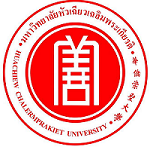Please use this identifier to cite or link to this item:
https://has.hcu.ac.th/jspui/handle/123456789/4343| Title: | 儿童舞台剧在泰国公立小学汉语教学中的实践研究——以WAT THEP LEELA SCHOOL 为例 |
| Other Titles: | การวิจัยเชิงปฏิบัติเรื่องละครเวทีสำหรับเด็กกับการเรียน การสอนภาษาจีนในโรงเรียนประถมศึกษาของไทย : กรณีศึกษาโรงเรียนวัดเทพลีลา Practical Research on Childen's Stage Drama in Chinese Class in Thai Public Primary School : Wat Thep Leela School as am Example. |
| Authors: | 尹士伟 Tanes Imsamran ธเนศ อิ่มสำราญ 钟艳红 Zhong Yanhong Huachiew Chalermprakiet University. College of Chinese Studies |
| Keywords: | ภาษาจีน -- การศึกษาและการสอน Chinese language -- Study and teaching ละครสำหรับเด็ก Drama for children ภาษาไทย -- การใช้ภาษา Thai language -- Usage การวิเคราะห์ทางด้านภาษา Linguistic analysis (Linguistics) การวิเคราะห์เนื้อหา Content analysis (Communication) 汉语 -- 学习和教学 内容分析 泰语 -- 语言使用 |
| Issue Date: | 2024 |
| Publisher: | Huachiew Chalermprakiet University. |
| Abstract: | Children's stage plays are practiced in the classroom teaching of international Chinese education. Performances are used to assist language teaching, and children's desire to explore and learn is stimulated in the process of active participation. Children's stage play education is a teaching method in which teachers impart professional knowledge and develop students' various skills through the process of organizing, rehearsing, and performing children's stage plays. Children's stage play is a comprehensive stage performance art that includes language and literature, singing and dancing, costume modeling, stage lighting, and background music. It uses a variety of different art forms to interpret the storyline in the script and the emotions and anger of the characters. Various emotions such as sadness and joy allow the audience to be immersed in the scene and feel the influence of art. This kind of performance can not only cultivate children's creativity, imagination, language expression ability and enhance their self-confidence, but also stimulate children's interest in learning Chinese, improve children's pragmatic ability, communicative ability and cultivate cross-cultural communication awareness. It plays a vital role. This article consists of an introduction, four chapters and a conclusion. The introduction is the opening part, and its main content includes the purpose and significance of the topic, research objects, research innovation, research review and research methods. The first chapter is an overview of children's stage plays. This chapter is mainly divided into three sections. The first two sections elaborate on the characteristics and functions of children's stage plays by discussing the relevant concepts and definitions of children's stage plays. By sorting out and elaborating on the development overview of children's theater education, this topic can be made Continue to move forward based on previous research. Section 3 discusses the theoretical origin of children's stage drama education. By in-depth discussion of the theoretical origin of children's stage drama education, we can better understand its value and significance in international Chinese education and teaching, and promote children's language acquisition and all-round development. The second chapter is the teaching design of children’s stage drama in the Chinese teaching of WAT THEP LEELA SCHOOL in Thailand. This chapter is mainly divided into seven sections to elaborate on the analysis of teaching objects, teaching content and teaching resources, teaching objectives and teaching principles, teaching strategies and teaching methods, class settings, teaching steps, and link ideas. They play a guiding role in the implementation of classroom teaching activities. Chapter 3 is the teaching case design of children’s stage drama practice in Chinese teaching at WAT THEP LEELA SCHOOL in Thailand. This chapter has three sections, showing the teaching cases of children's stage plays in Chinese teaching at WAT THEP LEELA SCHOOL in Thailand, and illustrating the practice process of children's stage plays in Chinese teaching. Chapter 4 is the teaching results and teaching reflections of the practice of children’s stage drama in Chinese teaching at WAT THEP LEELA SCHOOL in Thailand. This chapter has two sections. The first section discusses in detail the teaching results of children's stage drama in Chinese teaching at WAT THEP LEELA SCHOOL in Thailand. The second section reflects on the successes and shortcomings. Finally, the conclusion part summarizes the implementation process and results of this research and puts forward eight suggestions for the implementation of children's stage drama in Chinese teaching in Thai public primary schools. 儿童舞台剧在国际中文教育的课堂教学中实践,用表演来辅助语言教学,儿童在积极参与的过程中激发其探索和学习的欲望。儿童舞台剧教育是通过在组织、排练、表演儿童舞台剧的过程中,施教者给学生传授专业知识和培养学生各项技能的一种教学法。儿童舞台剧是一门包括了语言文学、歌唱舞蹈、服装造型、舞台灯光、背景音乐的综合性舞台表演艺术,它用多种不同的艺术形式来演绎出剧本中的故事情节,人物的喜怒哀乐等各种情绪,让观众身临其境,并感受到艺术的熏陶。这种表演不仅能够培养儿童的创作力、想象力、语言表达能力和增强其自信心,还激发了儿童对汉语学习的兴趣,对提高儿童的语用能力、交际能力和培养跨文化交际意识都起着至关重要的作用。 本文由绪论、四个章节和结语组成,绪论作为开篇部分,主要内容包括选题目的与意义、研究对象、研究创新、研究综述和研究方法。 第一章是儿童舞台剧的概述。 本章主要分为三节来论述,前两节通过对儿童舞台剧的相关概念和定义的论述,阐述了儿童舞台剧的特征和作用,通过对儿童戏剧教育的发展概况梳理和阐述,能够使本课题在前人研究的基础上继续前进。第三节论述了儿童舞台剧教育的理论来源,通过深入探讨儿童舞台剧教育的理论来源,能更好地理解其在国际中文教育教学中的价值和意义,促进儿童的语言习得和全面发展。 第二章是儿童舞台剧在泰国WAT THEP LEELA SCHOOL汉语教学中实践的教学设计。 本章主要分为七节详细的阐述了教学对象分析、教学内容与教学资源、教学目标和教学原则、教学策略和教学方法、课时设置、教学步骤、环节思路。它们对课堂教学活动的实施起到了指导作用。 第三章是儿童舞台剧在泰国WAT THEP LEELA SCHOOL汉语教学中实践的教学案例设计。 本章共有三节,展示了儿童舞台剧在泰国WAT THEP LEELA SCHOOL汉语教学中实践的教学案例,说明了儿童舞台剧在汉语教学中的实践过程。 第四章是儿童舞台剧在泰国WAT THEP LEELA SCHOOL汉语教学中实践的教学成果与教学反思。 本章共有两节,第一节详细的论述了儿童舞台剧在泰国WAT THEP LEELA SCHOOL汉语教学中实践的教学成果,第二节是反思成功与不足。 最后是结语部分,总结了本课题研究的实施过程、成果和提出了儿童舞台剧在泰国公立小学汉语教学中实施的八点建议。 |
| Description: | Thesis (M.A.) (Teaching Chinese) -- Huachiew Chalermprakiet University, 2024. |
| URI: | https://has.hcu.ac.th/jspui/handle/123456789/4343 |
| Appears in Collections: | College Of Chinese Studies - Theses |
Files in This Item:
| File | Description | Size | Format | |
|---|---|---|---|---|
| Ms. ZHONG YANHONG.pdf Restricted Access | 2.98 MB | Adobe PDF | View/Open Request a copy |
Items in DSpace are protected by copyright, with all rights reserved, unless otherwise indicated.
